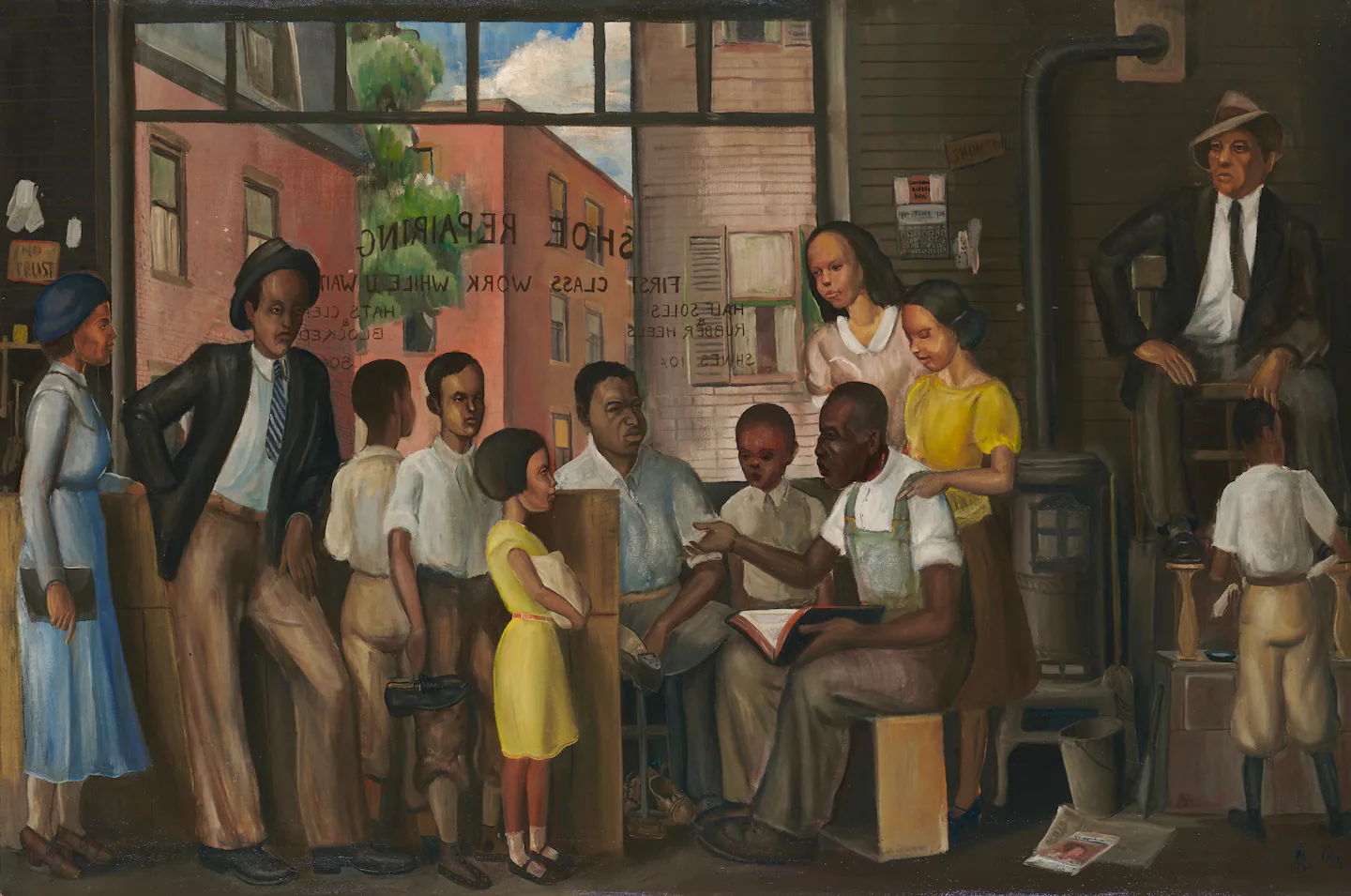Copyright The Boston Globe

There is inevitable crossover, but you need to see both. Crite was devoted to Boston, his Boston, though this is the first time Boston has loved him back in equal measure. It’s sobering, indeed, that his moment finally comes as his Boston is now all but gone. But his pictures connect us both to the ruptures of massive, rapid urban change, its irrevocable costs, and the grace and joy to be found in its fractures. A short stroll from Copley Place and the Prudential Center, Crite’s old home on Columbus is a reminder that central Boston, and especially the South End, with its slick bistros, boutiques, and sky-high real estate, wasn’t always like this. Walk into the Athenaeum show, and a different time comes to life on the walls. In the 1930s, Crite, who was born in 1910, started his “Neighborhood Series,” a lifelong pursuit to capture the world that had nurtured his undying sense of community. The Athenaeum show is full of Crite’s watercolors, a particular treat in their breathless immediacy and bountiful joy in the moments they capture: “On Old Northampton Street,” 1939, a trolley rumbles alongside the red brick sidewalks, past neighborhood strollers ducked under the shade of ebullient swipes of green that capture the windblown rustle of leaves; in “A Maternity Club” and “A Course in Music Appreciation,” 1940, loose gatherings of friends and neighbors cluster around benches with a pram or a record player, exulting in each others’ company. Crite attended the School of the Museum of Fine Arts, a healthy but still walkable stroll from his home, and exulted in the collections of nearby museums like the Gardner, the MFA, and especially the Athenaeum, which is now the largest repository of his work; in those adventures, urged by his mother, Annamae, a poet, Crite discovered a city of vast wealth and cultural riches all but foreign to his own experience barely a couple of miles away. One watercolor, “Meeting at St. Gaudens Shaw Memorial‚” 1944, captures the iconic tribute to the Black regiment of the Union Army. It’s poignant — Crite, paying homage to a white artist, in St. Gaudens, who immortalized the sacrifice of Black soldiers during the Civil War. Crite’s scenes are quotidien, but remarkably humane — lovingly-crafted depictions of a milieu, and a people, long left beneath the regard of so-called high art. Crite once said that he’d “only done one piece of work my whole life … I wanted to paint people of color as normal humans. I tell the story of man through the Black figure.” And when that figure is absent, another story emerges. Crite’s perch between the South End and Lower Roxbury was not only a front-row view of Boston’s Black community; by the 1940s, it was also a ringside seat to the devastation of urban renewal. Among his many and multifarious roles, Crite was surely a documentarian of the daily churn of life in the world close at hand. When the bulldozers came, displacing thousands in the urban core to make way for highways and housing projects, Crite turned his compassionate eye to the radical indifference of state-driven devastation. In “33B in Action,” 1940, a steamshovel imposes on the foreground of his frame, shoving aside broken brick to clear way for the Lenox Street Housing Projects in Lower Roxbury ”Wrecking Old Houses,” 1940, bleak and brusque, captures dilapidated clapboard homes almost in a defensive crouch as the wrecker rears back for the killing blow. Crite was no mere observer of the wreckage. His family had first lived on Shawmut Avenue in the South End, arriving in 1910 from New Jersey when he was just a year old. In 1925, the Crites moved to Dilworth Street in Lower Roxbury, where they lived until 1971, when the wrecking ball came for them, too. It was then that Crite and his mother moved to Columbus Avenue, safe from the devastation, at least the most obvious kind. He would still be alive to see the slow creep of gentrification in the South End accelerate in the early 2000s, a distant early warning of a community under new threat. Is that why Crite, with his refined understanding of the history of art, adopted the role of neighborhood activist, too? Partly, no doubt. At both the Athenaeum and the Gardner, Crite’s love of community is crystal clear. It comes through at the Athenaeum especially, where his chronicles of the city hang throughout the building, far beyond the confines of the exhibition itself. (Wander into the reading room overlooking the Granary Burial Ground and you’ll see plenty, including the terrific “Marble Players,” 1934, a dusty paean to the pleasure of neighborhood gatherings.) But Crite didn’t confine his affections, and his devotions, to the canvas or page. 410 Columbus was a gathering place for art and politics alike. Dana Chandler, the firebrand artist and activist who agitated for — and got — an exhibition of Black artists at a deeply-resistent MFA in 1970, was a close friend. So was Mel King, the legendary Boston activist and mayoral candidate. Crite made the main floor at 410 Columbus the home base for his Rainbow Coalition party. In the 1960s, Crite abandoned painting and drawing almost entirely for printmaking, largely so he could reproduce his work in multiples and give it away; he wanted his friends and neighbors to have it in their homes. And as his own home filled with more and more of his art, he opened it to school groups and others, an informal living museum of the history and culture of the neighborhood, and people, he loved. At the Gardner, a clarity for Crite’s love of community intertwines with his spirituality, a north star in art and life. Amid the delights of street scenes like “School’s Out,” 1936, an ebullient burst of children tumbling through the schoolyard and into the streets, Crite’s spiritual life comes into sharp view. Fourteen panels detailed in gold leaf depict Christ and the Stations of the Cross. His 1945 Annunciation Scene made of pressed copper glimmers in the gallery’s low light. In “The Children’s Mass,” 1936, a clutch of young Black children gathers near the altar. Most moving to me, though, is the remarkable “Streetcar Madonna,” from 1946. With a Black Virgin Mary holding a beatific Black Jesus, aglow and riding the Columbus Avenue trolley, Crite makes clear: Where some may have seen urban poverty, he saw community worthy of holy reverence. That spirit never left him, of course, though his beloved community found it harder and harder to stay in the rapidly gentrifying South End toward the end of his life. Ted Landsmark, a professor of public policy and urban affairs at Northeastern University and a co-curator of the Gardner exhibition, had worked with Crite, his close friend, to make 410 Columbus into an official house museum, but to no avail. So, the broad Crite-fest between the two museums, finally, will have to do. And, amid the bistros and boutiques, the plaque: History “is the memory of the past which shapes the present and gives guidance to the future,” it quotes him as saying. “I am a storyteller of my view of the African American experience.” As the bard of a Boston no longer in sight, Crite brings a vibrant past to light and makes a future centered on community and compassion a little easier to see. ALLAN ROHAN CRITE: URBAN GLORY and GRIOT OF BOSTON Through Jan. 19 (Gardner) and Jan. 24 (Athenaeum). Isabella Stewart Gardner Museum, 25 Evans Way. 617-566-1401, www.isgm.org; Boston Athenaeum, 10½ Beacon St. 617-227-0270, bostonathenaeum.org



